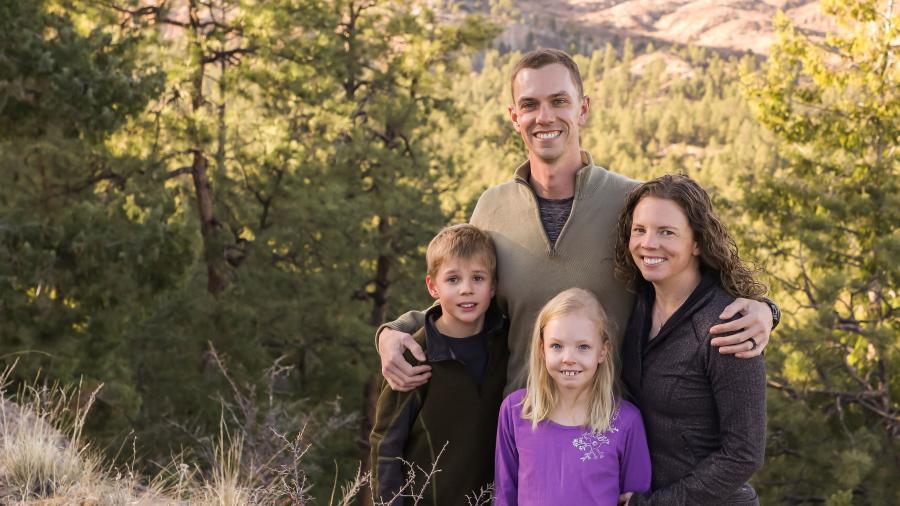Westmont Magazine A Nuclear Family Thrives at Los Alamos

Shea Mosby ’07 and Michelle Evans Mosby ’07 arrived at Westmont with specific and disparate plans that changed and aligned during their college years. Today they both work as research scientists at Los Alamos National Laboratory in Los Alamos, New Mexico. In 2019, Shea received the Presidential Early Career Award for Scientists and Engineers, the U.S. government’s highest honor for outstanding scientists and engineers in the early stages of their independent research careers.
“Shea is a deep-thinking early career scientist who has contributed to many of the nuclear reaction measurements done at the Los Alamos Neutron Science Center. He is currently developing a novel concept to measure nuclear reactions in radioactive isotopes,” said David Meyerhofer, Physics Division leader.
At their parents’ urging, Shea and his brother, Evan Mosby ’07, enrolled at Westmont, where their aunt, Jan Mosby Ochs ’85, and her husband, Kevin Ochs ’85, earned their college degrees. As a child, Shea loved history but eventually decided to pursue engineering, a more lucrative field. He started Westmont’s 3-2 engineering program intending to finish at Cal Poly San Luis Obispo. Then he met physics professor Warren Rogers and took a class in modern physics. “I found relativity and nuclear physics really fascinating,” Shea says. Rogers invited him to learn more about the field during summer research at Westmont. “I started reading papers about an entire world I didn’t know existed,” Shea says.
Rogers collaborated with physicists at Michigan State on research funded by the National Science Foundation at the National Superconducting Cyclotron Laboratory, and he took students there to work on the Modular Neutron Array (MoNA). Shea and Evan participated in experiments studying nuclear structures and became familiar with the advanced, specialized equipment, a rare opportunity for undergraduates. Back at Westmont, they helped construct the Westmont Cosmic Muon Detector Array, modeled on MoNA, which tracked the flux of cosmic muons in the Santa Barbara sky.
“I thought it was cool that these experiments were controlled chaos,” Shea says. “Even the experts didn’t know what was going on or what the answer would be. If you don’t see what you expect, is that a problem, an error or physics? I wanted to do more of that. So I switched my major from engineering physics to a Bachelor of Science in physics and continued doing research with Warren. Not knowing the answer was exciting.” Shea spent two summers in the Westmont lab, including several weeks at Michigan State, and took time out to earn some money by cutting hay on his grandfather’s ranch. He began thinking about graduate school in physics.
Meanwhile, Michelle arrived at Westmont from Colorado as a pre-med student and a chemistry major, drawn by the beach and the change of pace from her home state. She and Shea met in class and in Clark Halls their first year. Then she suffered a bad accident in Colorado during spring break and finished the semester at home. “I came back my sophomore year floundering,” she says. Chemistry professor Allan Nishimura reached out and asked her to do research with him. “It won’t hurt your pre-med program, and you could enjoy it,” he said. The experience gave her direction. “I found interesting problems to solve and ways to approach the research,” she says. “I took ownership and designed my own experiment, and I was interacting with professors, not graduate students. I also got to go to conferences and even met a Noble Laureate.” Rogers convinced her to add a second major in physics.
Michelle set aside the idea of medical school and focused instead on graduate programs in chemistry. “I knew I wanted to solve interesting problems and go to a good graduate school,” she says. “I cornered Shea and said, ‘I feel like we’re going to get married, so let’s look at graduate schools that work for both physics and chemistry.” They got engaged the fall of their senior year.
“We were nervous about the dual challenges of our first year of marriage and the rigor of graduate school coinciding,” Michelle says. “Professor Niva Tro advised us that we could work through it together, so we embraced the challenge.” They both earned doctorates at Michigan State, she in nuclear chemistry and he in experimental nuclear physics. “We shared an office and worked on the same equipment,” she says. “We learned when we did lab work at Westmont that we could work really well together.”
“Our brains function differently, so we attack different parts of a problem, and that worked out really well,” Shea says. “When we set the scope of an experiment, we figured out ahead of time who would do what.”
They defended their dissertations when their son and first child was 9 months old. Shea obtained a post-doctoral fellowship at Los Alamos in 2012 studying neutron capture reactions for nuclear technology applications. He became a technical staff member in 2014 and now leads projects studying the process of nuclear fission. He studies interesting problems with real-world applications, contributing to both basic and applied scientific fields.
“Los Alamos offers lots of opportunities for people with scientific backgrounds,” Michelle says. She took some time off when her children were born—Oliver is 9, and Emma is 7—and now works in global security. “We work in diverse areas of the lab but have found opportunities to collaborate using our unique perspectives,” she says.
Shea and Michelle chose Los Alamos for its great outdoor activities as much as for the career possibilities. “We spend a lot of time outside as a family, riding mountain bikes, running on trails, skiing and backpacking” Michelle says.